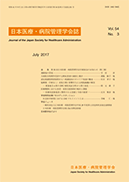Volume 55, Issue 4
Displaying 1-4 of 4 articles from this issue
- |<
- <
- 1
- >
- >|
Perspective
-
Article type: Perspective
2018 Volume 55 Issue 4 Pages 169
Published: 2018
Released on J-STAGE: April 16, 2019
Download PDF (124K)
Research notes
-
Article type: Research notes
2018 Volume 55 Issue 4 Pages 173-183
Published: 2018
Released on J-STAGE: April 16, 2019
Download PDF (438K) -
Article type: Research notes
2018 Volume 55 Issue 4 Pages 185-195
Published: 2018
Released on J-STAGE: April 16, 2019
Download PDF (455K) -
Article type: Research notes
2018 Volume 55 Issue 4 Pages 197-208
Published: 2018
Released on J-STAGE: April 16, 2019
Download PDF (424K)
- |<
- <
- 1
- >
- >|
